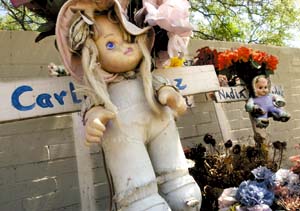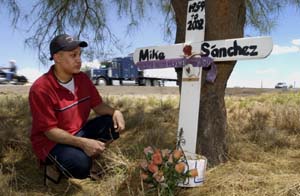

Tuesday, 3 September 2002
http://www.azstarnet.com/star/today/20903ROADSIDEMEMORIALS.html
 |
Photos by A.E. Araiza / Staff
| Weather-worn dolls and bouquets adorn crosses marking the site of a 1997 crash in which a speeding driver plowed into a minivan, killing eight members of two families. |
 |
| Michael Sanchez visits a roadside cross marking the site of his father's death earlier this year. "It's a memorial for people to know what happened," the 18-year-old says. |
By L. Anne Newell
ARIZONA DAILY STAR
IT used to be that Michael Sanchez didn't think a lot about the eight white
crosses standing near his family's house.
They'd been there since his family moved to the neighborhood in 1998, like silent
soldiers, a lingering memory of a car collision that killed eight people, five
of them children.
Then Sanchez's father died in February in a car accident at Interstate 10 and Palo Verde Road. The family put a cross there.
"I think they're really important," Sanchez, 18, says now. "It's a memorial for people to know what happened."
Roadways across the country are dotted with crosses and other markers. It's at least a centuries-old tradition, a Tucson folklorist said - a way for the living to remember those they have lost and a religious ceremony for some, to mark the holy spot where a soul has left a body.
But they're not without controversy. One such memorial is the focus of a court battle in Colorado. And officials across the country are finding different ways to handle the markers.
Lined trails in early days
Tucson folklorist Jim Griffith said the memorials began in Arizona in the Catholic community for people who died without having the chance to be absolved of sin.
They lined trails in their early days, and passers-by would stop, light a candle or say a prayer, Griffith said.
In 1783, the bishop of Sonora asked Spanish military authorities to forbid the practice because it discouraged other settlers, Griffith said. It was forbidden, he said, but it didn't stop.
The state Highway Patrol used white crosses in the 1940s and 1950s to mark the places motorists died, Griffith said. It has stopped the practice, but the markers continue to be placed by others.
"There still are people who take these as an indication they should say a prayer for the repose of the people who died there," he said.
Protected in New Mexico
In New Mexico, where people have made grave markers out of flowers, pumpkins, tin cans and other materials since Spanish rule, memorials are protected as "traditional cultural properties" through the Historic Preservation Division.
Last year, roadside memorials, also known as descansos (resting places), crucitas and memorias, were banned as traffic hazards in North Carolina.
California memorials are "discreetly removed" as road hazards, except when a victim was killed by a drunken driver who is convicted. Then, the state will erect a sign for $1,000.
In Florida, the state will put up a nondenominational marker for free, upon request.
In West Virginia, memorials are protected by a 2000 statute and can remain indefinitely if registered with the state.
And in Idaho last year, legislators replaced a program under which gold stars were placed at accident sites with a policy allowing roadside memorials.
"We leave them there"
Arizona traffic officials say they don't mind the memorials - if they aren't permanent and don't cause traffic hazards or impede road maintenance.
"There's really not a law or a written policy," said Walt Gray, a state Transportation Department spokesman. "Our general policy is we leave them there."
Crews will even move a memorial rather than remove it.
"We recognize that it's something important to the families for their closure," Gray said.
Michael Graham, spokesman for the city's Transportation Department, and Carol Anton, in community relations in the county Transportation Department, said their agencies' stances are similar. They just ask people to be cautious in erecting the signs.
"This is a very sensitive issue," Graham said. "People are mourning, and they need an opportunity to mourn."
Colorado court battle
That opportunity has led to a court battle in Colorado.
Brian Rector, 18, died in March 1998 when his Ford Escort was hit by a semi.
After the cremation and funeral, a family friend took some 2-by-4s and paint and fashioned a 3-foot-tall white cross, inscribing it "Son, Brother, Friend."
Relatives added flowers and small angel figurines.
"Because we don't have a cemetery plot to go to," Rector's mother, Deena Breeden, said, "we definitely want to keep up the memorial forever."
A driver who often passed Rector's memorial and others disagreed - and took action one night in April 2000.
A state trooper saw Rodney Lyle Scott's truck on the side of the road with its hazard lights on. A collection of flowers and wooden crosses was in the bed.
Scott told the trooper he was "cleaning up the interstate." Thinking Scott had permission, the trooper let him go.
Soon, the Breedens and other families noticed their memorials missing and complained. They found a sympathetic ear at the office of Adams County District Attorney Robert Grant.
Scott, identified through his license number taken by the trooper, was charged with "desecration of a venerated object" and faced the possibility of six months in jail and a $750 fine.
"I had gone through a lot of personal turmoil myself," Scott said. "I didn't appreciate somebody else throwing their hurt and sorrow out for the public view, as if it was more important than someone else's."
Denver attorney Bob Tiernan, a member of the Madison, Wis.-based Freedom From Religion Foundation, offered to represent Scott for free.
The memorials "are using public property to endorse religion," Tiernan said. "It's a violation of the U.S. Constitution, as far as I'm concerned, and it's a serious distraction."
In April 2001, Tiernan won acquittal for Scott when a judge ruled the Rector memorial was "discarded refuse" and "unlawful advertising" under the law, not a venerated object.
The district attorney appealed and said he'll take the case to the state Supreme Court.
The memorials, he said, "are to venerate the life and passing of the person involved in the fatal accident, and at the same time serve the public purpose in getting people to slow down."
The Breedens were allowed to put a memorial back up - its cross removed, they said, to keep from offending anyone - without receiving a citation.
White cross is memorial
Michael Oscar Sanchez was 43 when he was thrown from his truck in February as it rolled across I-10 near Palo Verde.
He'd been eastbound on I-10 when he veered off the road, scraping along a guardrail for nearly 100 feet. He overcorrected, driving across the eastbound lanes and into the median, where his truck rolled and he was thrown outside. The vehicle flipped once and came to rest in the westbound lanes.
A white cross memorializes the spot now, marked with his name, birth date and death date.
"I think they should leave it there," Sanchez's son said as he stood outside his family's home, about 50 feet from the large collection of crosses at West Corona and South San Fernando roads.
Other memorials dot the streets in this South Side neighborhood. They mark the roads on the Tohono O'odham Reservation. And, increasingly, they're appearing all around Tucson, in various forms.
The one near the Sanchez house marks where Carlos Manuel Peralta ran a stop sign going about 65 mph in 1997, plowing into a minivan and killing eight members of two families. Peralta was sentenced to more than 200 years in prison.
It was one of the worst car crashes in Tucson's history. Neighbors have maintained the memorial since, and the victims' relatives still visit it. Stuffed animals, dried and silk flowers, and a rock border mark the spot, which Sanchez says he thinks of differently now.
But the Pima Community College freshman - who's studying administrative justice - doesn't think every state should be as lenient as Arizona.
He suggests standards for states where the memorials are being challenged.
"I think it should be a state-by-state decision," he said. "If it distracts someone, I don't think it should be there."
Joe Villa Jr., who raced out of his home to help the victims of the 1997 crash and whose family keeps watch over the memorial with other neighbors, said it's important to the neighborhood and the relatives of the victims.
"I think it shows a lot of people what can happen when you drink and do drugs and don't pay attention to the road signs," he said. "It's important for the family, too. They can leave a remembrance. They bring flowers or something. The spirits went to God in this spot."
* Information from The Associated Press was used in this report.
* Contact reporter L. Anne Newell at 629-9412 or lnewell@azstarnet.com.
Back to Story
--------------------------------------------------------------------------------
All content copyright © 1999, 2000, 2001 AzStarNet, Arizona Daily Star
and its wire services and suppliers and may not be republished without permission.
All rights reserved. Any copying, redistribution, or retransmission of any of
the contents of this service without the expressed written consent of Arizona
Daily Star or AzStarNet is prohibited.